How long does it take wet clothing to freeze? I went out on the Weather Patio with some of my old tee shirts for an experiment to find the answer.
You've likely heard our First Warning Neighborhood Weather team stress the importance of wearing plenty of layers this cold week. It's also important to wear waterproof layers. Wet clothing causes faster body heat loss. When temperatures are in the single digits and we have negative wind chills, we don't want to lose any body heat to avoid frostbite and hypothermia.
Wind chill is a combination of wind speed and temperatures. This chart from the National Weather Service shows how wind chill is calculated. The different colors highlight frostbite times. The windier and colder it gets outdoors, the quicker it is to get frostbite.
With the right conditions, uncovered skin can get frostbite in 30 minutes or less. Areas like your nose, ears, toes, and fingers have less blood circulation, and tend to be more susceptible. How about freezing - how quickly can this happen? Let's jump to my experiment.
I soaked a tee shirt in room temperature water. I took the wet tee shirt outdoors, where we were in the low single digits. I left the shirt hanging on the Weather Patio. In less than 15 minutes, the shirt was completely frozen. A few icicles even formed on it.
Our photographer, Kyle, braved the cold to help show off our results.
Thanks Kyle for helping show the experiment results ? Drenched tee shirts turned frozen within 15 minutes ? You lose body heat quickly with wet clothes and negative wind chills. It’s important to wear waterproof clothes! @ABC57Newspic.twitter.com/X3xaTUiyIO
— Maci Tetrick (@mtetrick_wx) February 8, 2021
I ran the experiment four different times. The results were the same - all shirts froze in less than 15 minutes.
Most of us aren't running outdoors in a wet tee shirt in the winter. More realistic scenarios are clothes getting wet from playing in the snow, walking across campus, or scraping your car. If you notice you have wet gloves or shoes, go indoors and change to avoid losing body temperature.
Don't let this week catch you off guard. Here in South Bend, we typically only have three to seven days per year with wind chills in the negative teens to negative twenties, so it isn't a very common occurrence.
Even colder wind chills are in the forecast for this week, so this is a good lesson to learn near the beginning of our cold snap. Next time you hear us saying to "bundle up," remember that also means to stay warm by staying dry and wearing waterproof outer layers.
















